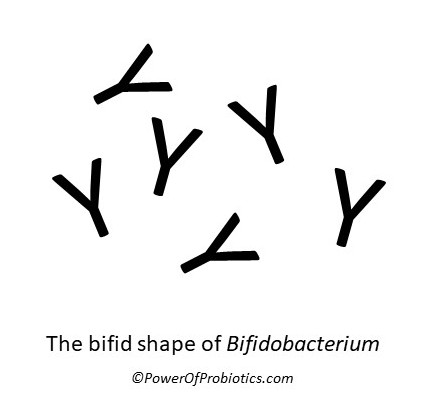Bifidus: A Special Kind of Probiotic?
Bifidus is a name that may be shown on probiotic supplement labels, foods and even in published research. The name is a Latin adjective meaning cleft, forked or divided. If you are confused by the name, you are not alone because some scientists around the globe investigating probiotics continue to use the name incorrectly.
The term can be found in other branches of biology/microbiology. There is a marine flatworm found in the Pacific Ocean, Astrotorhynchus, with at least five species in its category.
There is a fern-like shrub in Colombia, the Stecherus, with the term in its name that has divided leaves.
There is even a spider in Vietnam, the Pholcus, with the term in its name.
But since this is a site about probiotics, the focus here is on how the term is used in probiotics food, supplements and research.
What’s the Origin of Bifidus in the Probiotics World?
Lactobacillus bifidus was first described in 1900 by Tissier. It was also listed as a Bacillus species. The bacterium was described to be anaerobic. It was documented as being very common
in the feces of infants and possibly constituting nearly the entire
intestinal flora of breast-fed infants. It described a bacterial species that grows more readily in human than in cow’s milk due to a specific growth factor called the bifidus factor, or bifidogenic factor, which is a
compound that specifically enhances the growth of bifidobacteria. Today we know that a prebiotic in human breast milk has this enhancing effect.
Today we also know that in the probiotics world this bacterium is really Bifidobacterium, although sometimes it is used to denote the Bifidobacterium genus in general, the Bifidobacterium bifidum species in particular or another Bifidobacterium, such as B. lactis.
Often, it is used by clever marketers to make their probiotic seem more desirable, perhaps almost exotic, by naming it Bifidus DR10 or Bifidus Regularis. Nonetheless, there are still scientific publications, particularly outside the US, which mistakenly label it as a Lactobacillus or a Bacillus species. No wonder confusion abounds!
Other Examples of the Term in Probiotics

You can see from the forked appearance in this artist's rendition how the bifid Y-shape is found in Bifidobacterium. There are other places in the probiotics world where you will see the term used. Some of these are listed below.
In one study, Bifidobacterium bifidus BGN4 was used in a probiotic blend with Lactobacillus acidophilus and salivarius (Acronelle, Bromatech srl, Milan, Italy) combined with mesalazine therapy for mild to moderate ulcerative colitis. After two years, the patients treated with a single daily oral administration of mesalazine and a twice-daily administration of the probiotic blend showed better improvement. There was statistically significant improvement in physician’s global assessment, stool frequency, and endoscopy results, and rectal bleeding, particularly after 18 months. Later studies corrected the name to bifidum.
In another study, a bifidus milk powder was prepared by spray drying cow’s milk that was inoculated with Bifidobacterium bifidum before drying. This powder was used to provide superior nutritional quality over regular dried cow’s milk and longer shelf life, yet still provide aesthetic color, aroma and taste to taste panelists.
In molecular biology, there is a molecular pathway unique to Bifidobacteria in the Gram–positive bacterial world called the bifidus shunt. This pathway involves the conversion of glucose through the hexose fermentation pathway, also called the fructose-6-phosphate shunt, for ultimate conversion into short-chain fatty acids and other organic compounds.
Hopefully you now know what is meant by the term and won’t be confused by incorrect usage or fooled by misleading marketing of probiotics.
Go to Bifidobacterium page.
Go to Homepage.
I research studies and share my clinical experience to write this free site to help you find solutions to your problems. As part of that, I recommend products and services that I genuinely believe will be of help to you. If you click on a link to a product/service, I may receive a small commission to support my efforts if you buy something. The item does not cost you more.
Thanks for visiting this site! If you've enjoyed reading this page or have found the information to be useful to you, please "like", tweet about it, or share it so others can benefit, too. You can leave comments below via Facebook or Disqus.
Comment with Disqus (including as a guest), Twitter or Google accounts:
If you are one of my many readers without a Facebook account, you can still comment.
Disclaimer: Please note: By law, I cannot provide any personalized recommendations for your specific health concern on this site. The information contained in this site is educational in nature and is not intended as diagnosis, treatment, prescription or cure for any physical or mental disease, nor is it intended as a substitute for regular medical care. Consult with your doctor regarding any health or medical concerns you may have.
Subscribe to my monthly newsletter and receive a free copy of "How to Use Probiotics to Lose Weight and Be Healthier".

To comply with the EU's GDPR data privacy regulation, please subscribe here:
Looking for some quality professional supplements, including probiotics? Check out my online dispensary, as I will be doing reviews of some of these products in the future. Click on the Fullscript picture. (Note: If you were a former Wellevate customer, please switch to Fullscript for a better customer experience. Thanks!)
Some competitors of SBI (Solo Build It) are posting fake negative reviews of SBI. If you are considering creating your own website business, or if you have a brick-and-mortar business but want an online presence, I highly recommend SBI!





Comment with Facebook!
I'd love to hear your opinion about what you just read. Leave me a comment in the box below! Other commenting options follow the Facebook comments.